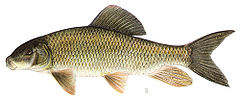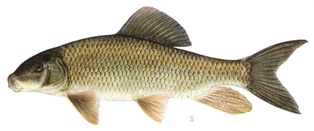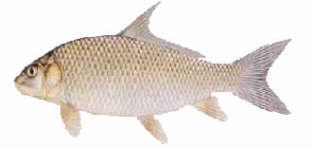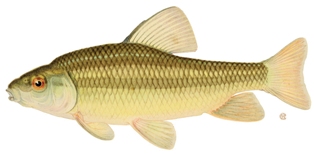Discover Florida Nature
It's time to explore the natural Florida


|
|
|
|
|
 Blacktail
Redhorse
(Moxostoma poecilurum) The blacktail redhorse may be
readily separated from all other Florida suckers by the color
pattern of the tail fin. The lower lobe of the tail fin is
bordered lengthwise by a white band. Above this white edge is a
parallel black band which extends from the base of the tail to
the rear edge of the fin. Otherwise, this elongate, cylindrical,
moderately compressed sucker superficially resembles the spotted
sucker, river redhorse and greyfin redhorse. General body
coloration is bronze to brownish over the back, with silvery
sides and a white bottom. Color of all fins, except the tail,
varies from reddish to white. Blacktail redhorse are found in
all major river systems in the western Panhandle, from the
Perdido River, eastward to the Choctawhatchee River system.
Blacktail redhorse are abundant in moderate-size streams and
large rivers of northwestern Florida and apparently face no
immediate threats to their continued existence. Blacktail
redhorse inhabit both large rivers and their tributary streams
and may sometimes be found in reservoirs. Bottom types in
typical streams may vary from soft sand or silt to gravel and
rock. Spawning takes place in shoal areas of small streams from
March to May. Two or three males may spawn with one female. They
may reach 20 inches in length and weigh 3.1 pounds. Blacktail
Redhorse
(Moxostoma poecilurum) The blacktail redhorse may be
readily separated from all other Florida suckers by the color
pattern of the tail fin. The lower lobe of the tail fin is
bordered lengthwise by a white band. Above this white edge is a
parallel black band which extends from the base of the tail to
the rear edge of the fin. Otherwise, this elongate, cylindrical,
moderately compressed sucker superficially resembles the spotted
sucker, river redhorse and greyfin redhorse. General body
coloration is bronze to brownish over the back, with silvery
sides and a white bottom. Color of all fins, except the tail,
varies from reddish to white. Blacktail redhorse are found in
all major river systems in the western Panhandle, from the
Perdido River, eastward to the Choctawhatchee River system.
Blacktail redhorse are abundant in moderate-size streams and
large rivers of northwestern Florida and apparently face no
immediate threats to their continued existence. Blacktail
redhorse inhabit both large rivers and their tributary streams
and may sometimes be found in reservoirs. Bottom types in
typical streams may vary from soft sand or silt to gravel and
rock. Spawning takes place in shoal areas of small streams from
March to May. Two or three males may spawn with one female. They
may reach 20 inches in length and weigh 3.1 pounds.  Grayfin
Redhorse
(Moxostoma) As its name implies, this sucker has plain
dusky or gray fins. Florida's other Moxostoma suckers,
the blacktail redhorse and river redhorse, have distinctively
colored fins. The lower portion of the tail fin is black and
white in the blacktail redhorse, and the tail fin is red in the
river redhorse. In addition, neither of these two suckers occur
together with the grayfin redhorse. The grayfin redhorse does
somewhat resemble the spotted sucker, with which it does
co-occur. However, the spotted sucker is readily identified by
the numerous black spots along its sides. The grayfin redhorse
is restricted to the Apalachicola River drainage of Florida,
Georgia and Alabama. Throughout its limited range it inhabits a
wide variety of stream types, ranging from small streams to
large rivers. Although it has been collected from reservoirs, it
rarely inhabits standing waters, and the impoundment of many
sections of rivers within the Apalachicola River system has been
a cause of its decline in some areas. It has been found in both
clear and turbid waters, in sluggish to moderate velocity
currents, and over sand, silt, gravel, rock rubble and bedrock.
Although its abundance has been reduced elsewhere, primarily by
impoundments, it is in no immediate danger of extinction in
Florida. Preservation of high quality habitat, such as the
Chipola River, will be the key to maintaining viable populations
in Florida. Grayfin
Redhorse
(Moxostoma) As its name implies, this sucker has plain
dusky or gray fins. Florida's other Moxostoma suckers,
the blacktail redhorse and river redhorse, have distinctively
colored fins. The lower portion of the tail fin is black and
white in the blacktail redhorse, and the tail fin is red in the
river redhorse. In addition, neither of these two suckers occur
together with the grayfin redhorse. The grayfin redhorse does
somewhat resemble the spotted sucker, with which it does
co-occur. However, the spotted sucker is readily identified by
the numerous black spots along its sides. The grayfin redhorse
is restricted to the Apalachicola River drainage of Florida,
Georgia and Alabama. Throughout its limited range it inhabits a
wide variety of stream types, ranging from small streams to
large rivers. Although it has been collected from reservoirs, it
rarely inhabits standing waters, and the impoundment of many
sections of rivers within the Apalachicola River system has been
a cause of its decline in some areas. It has been found in both
clear and turbid waters, in sluggish to moderate velocity
currents, and over sand, silt, gravel, rock rubble and bedrock.
Although its abundance has been reduced elsewhere, primarily by
impoundments, it is in no immediate danger of extinction in
Florida. Preservation of high quality habitat, such as the
Chipola River, will be the key to maintaining viable populations
in Florida. Highfin
Carpsucker (Carpiodes velifer) Along with its
cousin, the quillback, the highfin carpsucker superficially
resembles the common carp. However, both carpsuckers may easily
be separated from carp by the absence of barbels and lack of
spines in dorsal and anal fins of the two carpsuckers. Both
carpsuckers have the mouth positioned on the underside of the
head and the snout extends forward beyond the jaws. In addition,
the first ray of the dorsal fin may be very long, forming an
elevated filament. Quillback and highfin carpsuckers are quite
alike in appearance, but may be separated by looking at the
lower lip. The highfin carpsucker bears a small, nipple-like
structure, or knob, at the middle of the lower lip, while the
quillback lacks this nipple. Both carpsuckers may be
distinguished from other Florida suckers by body shape.
Carpsuckers are deep-bodied and compressed from side-to-side,
while other Florida suckers are more elongate or somewhat
cylindrical. General body color is silvery or brassy on the
sides, with the upper surfaces somewhat darker and the lower
body white or yellowish. Along the Gulf Coast, these suckers
range from Louisiana eastward to the Choctawhatchee River of
Florida. In Florida highfin carpsuckers are restricted to
moderate-to-large sized rivers and do not enter the smaller
tributary creeks, but in other areas they may do so. They prefer
clean waters and apparently are intolerant of siltation and
turbidity. Highfin carpsuckers may live as long as eight years
and reach a maximum size of about 20 inches and three pounds.
The highfin carpsucker is common in the Escambia and
Choctawhatchee rivers and appears to face no obvious threats to
its existence. However, it does appear to be susceptible to
siltation and other forms of environmental degradation. Highfin
Carpsucker (Carpiodes velifer) Along with its
cousin, the quillback, the highfin carpsucker superficially
resembles the common carp. However, both carpsuckers may easily
be separated from carp by the absence of barbels and lack of
spines in dorsal and anal fins of the two carpsuckers. Both
carpsuckers have the mouth positioned on the underside of the
head and the snout extends forward beyond the jaws. In addition,
the first ray of the dorsal fin may be very long, forming an
elevated filament. Quillback and highfin carpsuckers are quite
alike in appearance, but may be separated by looking at the
lower lip. The highfin carpsucker bears a small, nipple-like
structure, or knob, at the middle of the lower lip, while the
quillback lacks this nipple. Both carpsuckers may be
distinguished from other Florida suckers by body shape.
Carpsuckers are deep-bodied and compressed from side-to-side,
while other Florida suckers are more elongate or somewhat
cylindrical. General body color is silvery or brassy on the
sides, with the upper surfaces somewhat darker and the lower
body white or yellowish. Along the Gulf Coast, these suckers
range from Louisiana eastward to the Choctawhatchee River of
Florida. In Florida highfin carpsuckers are restricted to
moderate-to-large sized rivers and do not enter the smaller
tributary creeks, but in other areas they may do so. They prefer
clean waters and apparently are intolerant of siltation and
turbidity. Highfin carpsuckers may live as long as eight years
and reach a maximum size of about 20 inches and three pounds.
The highfin carpsucker is common in the Escambia and
Choctawhatchee rivers and appears to face no obvious threats to
its existence. However, it does appear to be susceptible to
siltation and other forms of environmental degradation. Lake
Chubsucker (Erimyzon sucetta) The lake
chubsucker and its close relative, the sharpfin chubsucker, are
chubby, heavy-bodied fish, but although they are somewhat
compressed from side-to-side, they are not nearly so slab-sided
as the carpsuckers and also lack the long, elevated dorsal fins
of the latter. The remaining Florida suckers, the spotted
sucker, and the three redhorses, have much more elongate and
streamlined body shapes than the chubsuckers. In addition, while
the mouth of the chubsuckers is located somewhat beneath the
head, the mouth of the spotted sucker and the redhorse suckers
is definitely positioned beneath the head in a down-turned
fashion. Adult males have a bilobed (two-lobed) anal fin. In
Florida, this species can only be confused with the sharpfin
chubsucker, with which it occasionally occurs in the western
Panhandle. As its name suggests, the sharpfin chubsucker has a
much more pointed dorsal fin than does the lake chubsucker, the
dorsal fin of which is somewhat rounded in profile. General body
coloration of lake chubsuckers is dark bronze, brown or olive on
the upper surfaces and lighter bronze over the sides, with the
undersides whitish. While most species of suckers prefer to live
in flowing streams, lake chubsuckers prefer quiet or sluggishly
flowing waters, usually being most abundant where the bottom is
soft, with much organic debris, and in areas of dense aquatic
vegetation. Lake chubsuckers have been recorded from a wide
variety of habitats, including lakes, ponds, impoundments,
oxbows, backwaters, floodplains, sloughs, bayous, roadside
ditches, springs, millponds, rivers, creeks, canals, wet
prairies, borrow pits, quarry pits and swamps. Lake chubsuckers
are common in Florida and face no obvious threats to their
existence. However, in other areas of the United States they
have become less numerous. Lake
Chubsucker (Erimyzon sucetta) The lake
chubsucker and its close relative, the sharpfin chubsucker, are
chubby, heavy-bodied fish, but although they are somewhat
compressed from side-to-side, they are not nearly so slab-sided
as the carpsuckers and also lack the long, elevated dorsal fins
of the latter. The remaining Florida suckers, the spotted
sucker, and the three redhorses, have much more elongate and
streamlined body shapes than the chubsuckers. In addition, while
the mouth of the chubsuckers is located somewhat beneath the
head, the mouth of the spotted sucker and the redhorse suckers
is definitely positioned beneath the head in a down-turned
fashion. Adult males have a bilobed (two-lobed) anal fin. In
Florida, this species can only be confused with the sharpfin
chubsucker, with which it occasionally occurs in the western
Panhandle. As its name suggests, the sharpfin chubsucker has a
much more pointed dorsal fin than does the lake chubsucker, the
dorsal fin of which is somewhat rounded in profile. General body
coloration of lake chubsuckers is dark bronze, brown or olive on
the upper surfaces and lighter bronze over the sides, with the
undersides whitish. While most species of suckers prefer to live
in flowing streams, lake chubsuckers prefer quiet or sluggishly
flowing waters, usually being most abundant where the bottom is
soft, with much organic debris, and in areas of dense aquatic
vegetation. Lake chubsuckers have been recorded from a wide
variety of habitats, including lakes, ponds, impoundments,
oxbows, backwaters, floodplains, sloughs, bayous, roadside
ditches, springs, millponds, rivers, creeks, canals, wet
prairies, borrow pits, quarry pits and swamps. Lake chubsuckers
are common in Florida and face no obvious threats to their
existence. However, in other areas of the United States they
have become less numerous. |
|
|
Advertise | Privacy Statement | Dog Encyclopedia | Video |Contact | Alaska Nature |
|